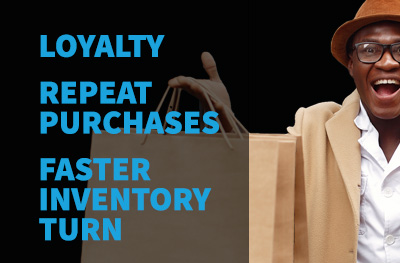Building Omnichannel across borders with Retail Pro Prism
Building omnichannel operations for multinational companies requires integrated technology designed for business agility. With the right set of tools, retailers can build their brands across geographic borders and still provide a consistent customer experience.
A successful project must nurture continuous experimentation and collaboration among all partners in the supply chain.
Managing the marketing, planning, and omnichannel operations for dozens, hundreds or even thousands of brands across many countries with numerous points of sale in Asia, South America or Europe is a huge challenge.
Collaboration and experimentation are needed to meet consumers’ rapidly evolving expectations and provide feedback to brand partners on local market preferences and upcoming trends.
Having functioning contacts and support systems in the region that a retailer is expanding to from the beginning makes such expansion much easier. Retail Pro has an expansive network of business partners who provide support in the initial implementation, and in any changes or hiccups throughout their operations.
Omnichannel POS and the customer experience

Omnichannel POS can support insights-driven experimentation.
To deliver connected customer experiences across digital touchpoints and stores, retailers integrate in-store point of sale (POS) systems, mobile POS, and omnichannel systems to their online stores, as well as their CRM and enterprise resource planning (ERP) systems.
That provides real-time visibility into sales down to the SKU level. Sales managers can strategize with customer-facing associates to develop and monitor the success of customized promotions and bundles for each store.
Customers also need to be a part of the feedback loop. They must trust the retailer, and feel that they have support throughout their journey – the item is in stock, ships quickly, can be returned easily if needed.
That trust often involves the customer providing some personal information to the store, in exchange for a more personalized shopping experience.
With an omnichannel POS system, a retailer can integrate their loyalty and rewards programs with data from their POS, making for a smooth transaction experience and more personalized and engaging customer experience, based on their actual purchase history.
A retailer can present a highly targeted experience if the data gathered is extremely focused.
Retail Pro Prism provides this omnichannel capability and customer experience and offers two loyalty programs – AppCard and OptCulture – for retailers to gain deep insight and create custom, individualized loyalty strategies.
E-commerce capabilities help retailers adapt to local markets as well.
The benefits gained by e-commerce apply to branded ecommerce sites as well as having a presence on online marketplaces such as Lazada, Little red Book, TMall, and Tokopedia.
Multinational omnichannel retailers choose robust software solutions to support its branded ecommerce platforms as well as middleware solutions to integrate systems with ecommerce marketplaces. That provides a solid foundation that lets e-commerce teams work seamlessly and efficiently across brands and marketplaces.
Retail Pro’s accessible API and extensive list of plugins and integrations in the Retail Pro App Market make it easy to integrate data from the POS, inventory and ecommerce.
Automating analytics and marketing in omnichannel

Standardized and automated back-end systems further boost efficiency.
Omnichannel warehouse and logistics managers automate their processes, from picking and packing, to shipping and final delivery.
A warehouse management system can further help by integrating enterprise resource planning, merchandising, and supply chain solutions.
Finally, business intelligence tools are deployed to deliver relevant insights across the entire enterprise.
BI can quickly generate insights by tracking clearly identified business and customer outcomes and analysts turn them into actions. For example, cross-analyzed data feeds coming from ecommerce marketplaces and social media can help identify small signals in certain product categories.
Retailers using Retail Pro can have access to several tools to help them in analyzing shopper and transaction data, such as Retail Pro Decisions – visual analytics software – and pre-designed reports in Retail Pro Reports. Retailers can use filters to focus on different aspects of their operations, and segments to investigate further on one period
Overall, the retailer is the “face” of the brands they represent, in every country. No matter how disparate the customers are from one location to the next, the retailer ultimately must use all the tools at its disposal to appeal to all, while maintaining a cohesive branding strategy.
Retailers personalize customer journeys by brand to connect with consumers. And brand promises must be aligned with in-market customer experiences, whether that’s online or in-store.
A loyalty program such as OptCulture for Retail Pro that centralizes sales data from customers in-store and ecommerce and gives you multiple avenues to reinforce their experience of your brand and offer automated, personalized marketing.
Read this article and more on the RPI blog.





